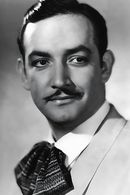Jorge Alberto Negrete Moreno was born in Guanajuato, Mexico, in November 1911, to a family of five brothers. His father, a General, retired and the family moved to Mexico City, where Negrete's father worked as a teacher, allowing Jorge and his brother David to study at the Humboldt German school, learning German, English, French, and Italian. Negrete also studied native Mexican language on his own.
He entered the military academy, graduating at 18 with high degrees as a Lieutenant of Cavalry and Administration, and worked in a weapon factory, starting medical studies and becoming an administrator at Puebla military Hospital. Negrete was diagnosed with hepatitis C during his youth, but it did not prevent him from smoking throughout his life.
In 1930, he began taking singing lessons from opera director José Pierson, and in 1931, he started singing on Mexican radio, adopting the name Alberto Moreno. Negrete retired from the Army in 1935 and debuted onstage in musical plays with Roberto Soto's company as a stage extra.
In 1936, he traveled to New York with a friend, performing as The Mexican Caballeros for NBC, and made a test for the Metropolitan Opera, but declined when only offered a substitution post. Instead, he got under contract with Eliseo Grener's Cuban orchestra.
Negrete made his first film appearance in the Warner Brothers short "Cuban Nights" and then starred in his first long-length feature, "La madrina del diablo" (1937). Fox put him under contract to make Spanish films, but the Actors Union reacted, and the idea was abandoned.
Negrete married actress Elisa Christy in 1940, and they moved to New York, where he wrote Spanish versions of English songs for Southern Music. Back in Mexico, he met actress Gloria Marín on the set of "¡Ay Jalisco... no te rajes!" (1941) and separated from Christy, who was pregnant with Negrete's daughter Diana.
Negrete and Gloria Marín lived together for 10 years and adopted a girl, Goyita. He starred in "The Rock of Souls" (1943),where he met María Félix, and had another resounding success with "Me he de comer esa tuna" (1945).












